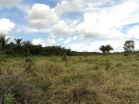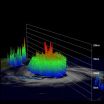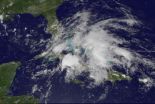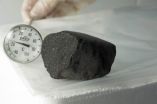(Press-News.org) The low pressure system that has been bringing rainfall to the northwestern Philippines has strengthened into the fifth tropical depression of the Northwest Pacific Ocean's hurricane season.
Tropical Depression 05W (TD05W) also known as Dodong in the Philippines was caught by infrared NASA satellite imagery on June 8 at 1741 UTC (1:41 p.m. EDT). The infrared data showed some powerful thunderstorms with very cold cloud top temperatures near the threshold of AIRS data of -63 Fahrenheit and -52 Celsius. That indicates the coldest, strongest thunderstorms within the tropical depression. Some of the strongest thunderstorms at that time were over western Luzon and stretched out over the South China Sea.
AIRS microwave imagery today showed that the banding of thunderstorms around the southern edge of the depression had the strongest storms. The storm's convection has decreased today. The decrease in convection is because of an upper-level trough (elongated area) of low pressure to the north that is preventing convection from occurring on the storm's northern side.
At 1500 UTC on June 9, TD05W was about 190 miles northwest of Manila, Philippines near 16.7 North and 118.4 East. It was moving to the north-northwest near 12 knots and had maximum sustained winds near 25 knots with higher gusts. It is now moving toward southern China and is expected to intensify into a tropical storm.
Warnings remain posted in the Philippines as TD05W continues pulling away.
INFORMATION:
NASA's Hurricane page: www.nasa.gov/hurricane
NASA catches system 92W become fifth NW Pacific tropical depression
2011-06-10
ELSE PRESS RELEASES FROM THIS DATE:
Advanced New eGreetings Website Launches
2011-06-10
An innovative new eGreetings website, www.iAttachments.com, officially opens for business today. For a $20 annual fee subscribers can send an unlimited number of greetings over the Internet. The distinctiveness of the service is 1) a short film with a song or a lyric video that tells a story appropriate for the greeting occasion, and 2) the core greeting is customized by the sender with an animated "envelope" preceding the film and an animated digital closing personalized with a message to the recipient follows
the film. Subscribers may also use the site's licensed ...
'Super varieties' of wheat expected to boost yields and block deadly threat to food security
2011-06-10
ST. PAUL, MN—Five years after the launch of a global effort to protect the world's most important food crop from variants of Ug99, a new and deadly form of wheat rust, scientists say they are close to producing super varieties of wheat that will resist the potent pathogen, while boosting yields by as much as 15 percent.
According to research to be presented at a global wheat rust symposium in Minneapolis starting June 13, scientists report that variants of the Ug99 strain of stem rust are becoming increasingly virulent and are being carried by wind beyond the handful of ...
Rebuilding The Amazon Rainforest One Tree at a Time
2011-06-10
What is Amazing Forest?
Yes, the Amazon rainforest is being cut down as you read this. 17% is already gone. The world's lungs - as it's referred to - is decreasing in size. Yes, everyone knows this. But what can we really do about it? The Amazing Forest is a chance to do something right from where you are, sitting in your chair, a few clicks and US$60 away.
Amazing Forest is the venue where people from all over the world are combining their efforts into one single strain to restore the Amazon rainforest to its original state.
We sell trees. Not trees to be delivered ...
NASA's infrared image of major Hurricane Adrian reveals its stormy life's blood
2011-06-10
Strong thunderstorms are the life's blood of tropical cyclones, and infrared and radar satellite data from NASA today confirms that the eastern Pacific Ocean's first hurricane has plenty of them and they're over 9 miles high. Adrian exploded in growth overnight from a tropical storm on June 8 to a major hurricane today.
NASA's Aqua satellite flew over Hurricane Adrian this morning at 8:29 UTC (1:59 a.m. EDT), and the Atmospheric Infrared Sounder instrument took an infrared snapshot of the storm's many strong thunderstorms and warm ocean water below.
The infrared data ...
Fragile X protein acts as toggle switch in brain cells
2011-06-10
New research shows how the protein missing in fragile X syndrome – the most common inherited form of intellectual disability – acts as a molecular toggle switch in brain cells.
The fragile X protein, called FMRP, hooks up with a group of molecules called microRNAs to switch the production of other proteins on and off in response to chemical signals, scientists at Emory University School of Medicine have discovered.
The results appear in the June 10 issue of Molecular Cell.
"For learning and memory to take place, neurons need to be able to make new proteins on demand, ...
Stretched-out low soaking the Caribbean in GOES-13 satellite imagery
2011-06-10
GOES-13 satellite imagery on June 9 shows that the pesky low pressure area in the north Caribbean Sea is stretching out and bringing soaking rains to Cuba, Hispaniola, Jamaica and Puerto Rico.
The Geostationary Operational Environmental Satellite called GOES-13 captured an image of this low on June 9 at 1740 UTC (1:40 p.m. EDT) System 94L, and the cloud cover appears centered over eastern Cuba and Jamaica while the outer portion of the low stretches over Hispaniola, Puerto Rico and now south Florida. The elongated low has a minimum central pressure of 1001 millibars and ...
Engaging high school students in soil science inquiry
2011-06-10
In April 2007, teacher Irka Elsevier and then-graduate student Biance Moebius-Clune began their second inquiry unit designed to enable high school students to better understand soil science concepts through their own research and experiments. Moebius-Clune was an NSF fellow in the Cornell Science Inquiry Partnerships (CSIP) program, which allowed the pair to develop inquiry curriculum to guide students through the process of doing research themselves.
Soil is fundamental to life and relevant to some of today's most pressing global issues, such as climate change and demand ...
NASA provides a 2-satellite view and video of the Chilean volcano eruption
2011-06-10
NASA's Aqua satellite and the GOES-13 satellite both captured their own unique views of the eruption of the Puyehue-Cordón Caulle volcano in Chile this week. One satellite provided a high-resolution image of the ash plume while the other provided a video showing the plumes movement over several days.
NASA's GOES Project released a satellite animation of the Puyehue-Cordón Caulle volcano that shows the movement of the ash plume over several days. The NASA GOES Project, located at NASA's Goddard Space Flight Center, Greenbelt, Md. created the animation from images obtained ...
Asteroid served up 'custom orders' of life's ingredients
2011-06-10
Some asteroids may have been like "molecular factories" cranking out life's ingredients and shipping them to Earth via meteorite impacts, according to scientists who've made discoveries of molecules essential for life in material from certain kinds of asteroids and comets. Now it appears that at least one may have been less like a rigid assembly line and more like a flexible diner that doesn't mind making changes to the menu.
In January, 2000, a large meteoroid exploded in the atmosphere over northern British Columbia, Canada, and rained fragments across the frozen surface ...
AgriLife research helps pave the way for a new livestock feed product
2011-06-10
AMARILLO – A two-year study by a Texas AgriLife Research team in Amarillo has helped bring a new product to market that could allow the cattle feeding industry to realize efficiencies in mills and more weight on cattle, according to Dr. Jim MacDonald.
MacDonald, an AgriLife Research beef cattle nutritionist, finished his second trial of cattle early this year studying starter diets in feedlots during the transition phase from pasture to feed yard.
Typically, a steer or heifer will come off of a forage diet when it goes into the feedlot, he explained. For the first ...





